

Lesson Planning and Creating a Teacher Plan Book. Lesson planning.

Every teacher’s got to do it. Microsoft Word - EL_Appendix_Protocols and Resources_080413.doc - appendix_protocols_and_resources. Educational Websites. Applying The 40/40/40 Rule In Your Classroom. I first encountered the “40/40/40 rule” years ago while skimming one of those giant (and indispensable) 400 page Understanding by Design tomes.
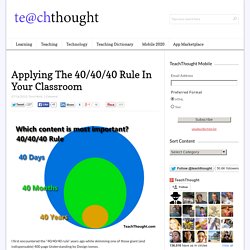
The question was simple enough. Of all of the academic standards you are tasked with “covering” (more on this in a minute), what’s important that students understand for the next 40 days, what’s important that they understand for the next 40 months, and what’s important that they understand for the next 40 years? As you can see, this is a powerful way to think about academic content. Of course, this leads to the discussion of both power standards and enduring understandings, curriculum mapping and instructional design tools teachers use every day. But it got me thinking. Not (Necessarily) Power Standards. Research and Information on Educational Leadership, Arts Participation, and After School Programs - The Wallace Foundation.
Tools for Teaching: Ditching The Deficit Model. Photo credit: iStockPhoto Children are more than one test, once a year, in one sitting.
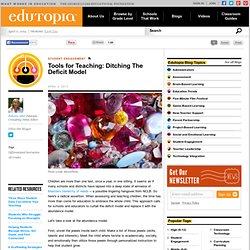
It seems as if many schools and districts have lapsed into a deep state of amnesia of Maslow's hierarchy of needs -- a possible lingering hangover from NCLB. So here's a radical assertion: When assessing and teaching children, the time has more than come for education to embrace the whole child. This approach calls for schools and educators to curtail the deficit model and replace it with the abundance model. Let's take a look at the abundance model. 5 Tools to Help Students Learn How to Learn. Helping students learn how to learn: That’s what most educators strive for, and that’s the goal of inquiry learning.
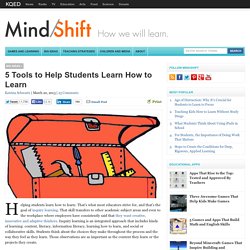
That skill transfers to other academic subject areas and even to the workplace where employers have consistently said that they want creative, innovative and adaptive thinkers. Inquiry learning is an integrated approach that includes kinds of learning: content, literacy, information literacy, learning how to learn, and social or collaborative skills.
Students think about the choices they make throughout the process and the way they feel as they learn. Those observations are as important as the content they learn or the projects they create. “We want students thinking about their thinking,” said Leslie Maniotes a teacher effectiveness coach in the Denver Public Schools and one of the authors of Guided Inquiry: Learning in the 21st Century. Creating Classrooms We Need: 8 Ways Into Inquiry Learning. If kids can access information from sources other than school, and if school is no longer the only place where information lives, what, then happens to the role of this institution?

“Our whole reason for showing up for school has changed, but infrastructure has stayed behind,” said Diana Laufenberg, who taught history at the progressive public school Science Leadership Academy for many years. Laufenberg provided some insight into how she guided students to find their own learning paths at school, and enumerated some of these ideas at SXSWEdu last week. 1. BE FLEXIBLE. The less educators try to control what kids learn, the more students’ voices will be heard and, eventually, their ability to drive their own learning. Laufenberg recalled a group of tenacious students who continued to ask permission to focus their video project on the subject of drugs, despite her repeated objections. 2. Laufenberg’s answer: Get them curious enough in the subject to do research on their own. 3. 4. 5. 6.
Looking at Student Work.
Heidi Hayes Jacobs on Curriculum 21: Resources, Key Points, Action Items, and Conversation Starters. Posted by Jonathan Martin under Uncategorized Leave a Comment A bracing, challenging, informative talk from Heidi Hayes Jacob enlivened our afternoon.
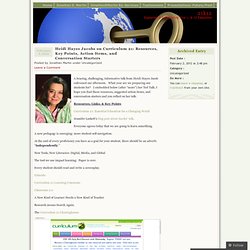
Missouri Department of Elementary and Secondary Education. Overview - The Reading. The mission of the Teachers College Reading and Writing Project is to help young people become avid and skilled readers, writers, and inquirers.
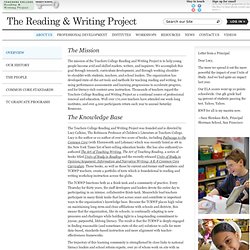
We accomplish this goal through research, curriculum development, and through working shoulder-to-shoulder with students, teachers, and school leaders. The organization has developed state-of-the-art tools and methods for teaching reading and writing, for using performance assessments and learning progressions to accelerate progress, and for literacy-rich content-area instruction. Thousands of teachers regard the Teachers College Reading and Writing Project as a continual source of professional renewal and education. Anne davies resources.
Vr's common core resources. Math common core. ELA resources. Growth Mindset Education Action Zone. Mbryson. What works best. This page has now been revised (May 2010) in the light of John Hattie's recent apparently definitive work Visible Learning; a synthesis of over 800 meta-analyses relating to achievement (London; Routledge, 2009).

The first thing to change has been the title, which used to be "What works and what doesn't". Hattie points out that in education most things work, more or less. The questions are around those which work best and therefore best repay the effort invested. Professional development that builds schools where all children learn. Dr.jean. If you can't find it here, try the Search Dr.
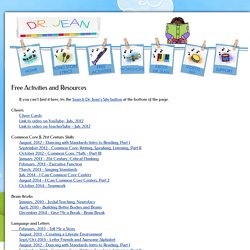
Jean's Site button at the bottom of the page. Cheers Cheer Cards Link to video on YouTube- July, 2012 Link to video on TeacherTube - July 2012. RTI Action Network.